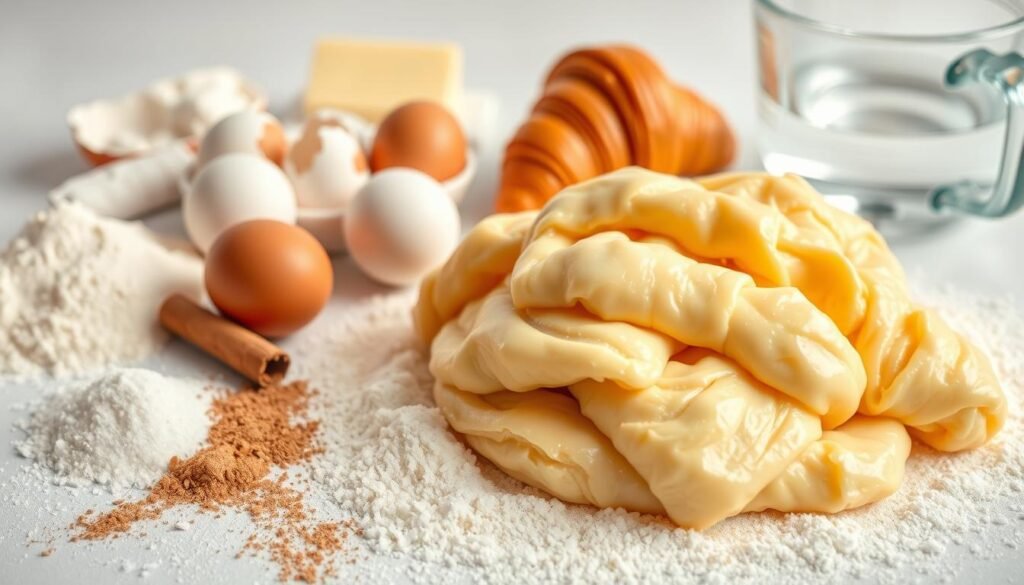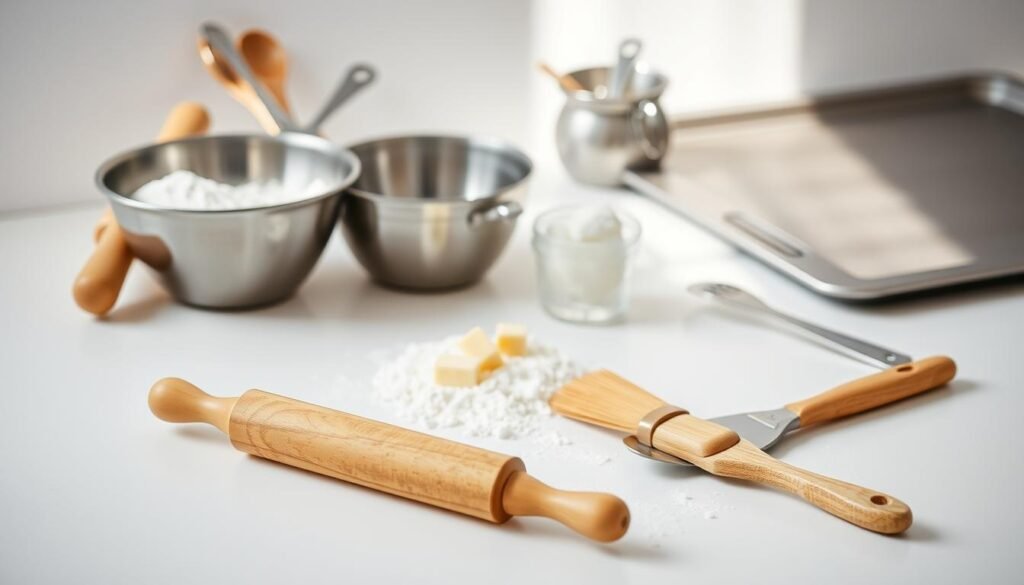I still remember the first time I bit into a flaky, buttery croissant. It was love at first taste! The layers of dough and the way they melt in your mouth are special. Plus, baking them from scratch is a joy.
Baking the perfect croissant is an art. It needs patience, skill, and a great recipe. Many of us love croissants with our morning coffee. But have you tried them with a savory chipotle chicken filling? It’s amazing!
In this article, I’ll share my favorite flaky croissant recipe. It’s sure to become a staple in your baking routine. With simple ingredients and expert tips, you’ll make delicious, flaky pastries that impress everyone.
Key Takeaways
- Simple ingredients are key to making the best flaky croissants.
- The layering process is crucial for achieving flakiness.
- Patience is essential when baking croissants from scratch.
- Experiment with different fillings, like chipotle chicken, for a unique twist.
- Practice makes perfect – don’t be discouraged by initial attempts.
Introduction to Croissants
Croissants have a rich history and a delicious taste. I’m excited to share both with you. These flaky pastries are loved by many around the world.
A Brief History of Croissants
The story of croissants is as complex as the pastry itself. They started in Austria as the kipferl, a curved bread. Then, they moved to France, where they became the croissant we love today.
The French made the recipe even better. They created a pastry that is both crispy and soft.
Some key points in the history of croissants include:
- The kipferl’s Austrian origins
- The adaptation and evolution in France
- The development of the lamination process
Why Homemade Croissants?
Making croissants at home lets you choose the ingredients and control the process. This way, your pastries are as fresh as possible. It might seem hard, but it’s worth it.
Some benefits of making croissants at home include:
- Customizing ingredients for dietary needs
- The joy of baking something from scratch
- Sharing freshly baked croissants with loved ones
The Joy of Baking Croissants
Baking croissants is more than just a recipe. It’s a mix of art, science, and patience. The process is calming, and the result is a tasty treat.
Remember, practice makes perfect. If your first batch doesn’t turn out right, don’t worry. With time, you’ll get better at making beautiful, flaky croissants.
Key Ingredients for Perfect Croissants
Making the perfect croissant starts with knowing the key ingredients. The quality and type of these ingredients greatly affect the taste, texture, and look of the croissant.
Flour: Choosing the Right Type
The flour you choose is very important for croissants. High-protein flour, like bread flour, is best because it gives the dough strength and structure. You can also use all-purpose flour, but it might change the texture a bit.
Butter: Importance of Quality
Butter is a key ingredient in croissant making. High-quality, European-style butter with lots of butterfat is the best choice. It makes the croissant taste better and helps create the flaky layers.

Yeast: Active vs. Instant
Yeast makes croissants rise. You can use active dry yeast or instant yeast, but they need different handling. Instant yeast is often used because it works fast and ensures a good rise.
Additional Ingredients: Sugar and Milk
Sugar and milk are important too. Sugar feeds the yeast, helping it rise better. Milk adds moisture and softness to the dough.
| Ingredient | Purpose | Recommended Type |
|---|---|---|
| Flour | Provides structure and strength | High-protein bread flour |
| Butter | Enhances flavor and creates flaky layers | High-quality, European-style |
| Yeast | Responsible for dough rise | Instant yeast |
| Sugar | Feeds yeast, adds sweetness | Granulated sugar |
| Milk | Adds moisture and tenderness | Whole milk |
Essential Tools for Baking Croissants
Baking croissants needs more than a good recipe; it needs the right tools. The right tools can make a big difference in getting that flaky texture. Just like a great chipotle chicken recipe needs the right spices, croissants need the right tools.

Baking Sheets and Parchment Paper
A good baking sheet is key for croissants. It gives a solid base for even baking. Use parchment paper to prevent sticking and make cleanup easy.
“The right baking sheet can be the difference between perfectly baked croissants and ones that are burnt or undercooked,” says an experienced baker.
Rolling Pins: Types and Benefits
Rolling pins are vital for croissant dough. You can choose from wooden, marble, or silicone. Marble keeps dough cool, which is great for temperature control.
The right rolling pin helps you get a smooth, even dough.
Measuring Tools for Precision
When baking croissants, precision is crucial. Use digital scales and measuring cups for accurate ingredient measurements. This ensures the right balance of ingredients, affecting texture and flavor.
“Measuring your ingredients with precision is the first step towards baking perfect croissants,” emphasizes a seasoned baker.
Step-by-Step Instructions for Making Croissants
Making croissants might seem hard, but it’s easier when you break it down. First, learn the basic steps from making the dough to shaping the croissants.
Preparing the Dough
To start, mix 1 1/2 cups of warm milk, 1/4 cup of sugar, and 2 teaspoons of yeast in a bowl. Wait 5-10 minutes for it to get frothy. Then, add 3 1/2 cups of flour, 1 teaspoon of salt, and 1/4 cup of melted butter. Mix until it’s a shaggy dough.
Knead the dough for 10 minutes until it’s smooth. Shape it into a ball and put it in a bowl with oil. Cover it and chill for 2 hours or overnight.
Laminating the Dough
Laminating is key for flaky layers. Roll the dough into a rectangle, about 1/4-inch thick. Make sure it’s even for good layers.
Soften 1 cup of butter to room temperature. Roll it into a rectangle the same size as the dough. Place the butter on the dough, making sure it’s centered.

Fold the dough over the butter like a letter. Rotate it 90 degrees and roll it out again. Do this three more times, chilling the dough for 30 minutes each time.
Shaping Your Croissants
Roll out the dough to 1/4 inch thickness. Cut it into long triangles with a pastry cutter or knife. Roll each triangle into a croissant shape.
Put the croissants on a baking sheet lined with parchment, leaving space between them. Cover them and let them rise for 1-2 hours, until they double in size.
By following these steps, you’ll make delicious, flaky croissants. Remember, it takes practice, so don’t worry if your first batch isn’t perfect.
Common Mistakes to Avoid When Baking Croissants
Baking croissants is more than just using the right ingredients and techniques. It’s also about avoiding common mistakes. Through my baking experiences, I’ve learned what errors can affect your croissants’ quality.

Overworking the Dough
One big mistake is overworking the dough. This makes the gluten too strong, resulting in tough croissants instead of flaky ones. To fix this, mix your ingredients just until they stick together. Then, let the dough rest. This helps achieve the right balance.
Not Chilling Ingredients Properly
Not chilling your ingredients correctly can also mess up your croissants. Cold butter and dough are key for flaky layers. Make sure your butter stays cold and chill your dough as the recipe says.
Ignoring Rise Times
Ignoring rise times can also lead to bad results. The rising process is important for flavor and texture. Be patient and let your dough rise as it should. This step is crucial for a light, airy texture.
Knowing these common mistakes and how to avoid them can greatly improve your croissant-baking skills. Remember, practice is key. Understanding these pitfalls is a big step towards baking delicious croissants.
Tips for Achieving Flakiness
Getting flaky croissants isn’t just luck. It’s about careful prep and knowing how to bake. To get it right, you need to focus on a few key things.
The Importance of Cold Ingredients
Using cold ingredients is key for flaky croissants. Cold butter and cold dough are must-haves. Warm butter makes the dough dense, not flaky.
- Keep your butter cold until you’re ready to use it.
- Chill your dough in the fridge for at least an hour before rolling.
Layering Techniques: More is More!
The layering process, or lamination, is what makes croissants flaky. It involves folding and rolling the dough to create layers of butter and dough.
- Roll out your dough to about 1/4 inch thick.
- Fold the dough in half, then fold it in half again, making four layers.
- Rotate the dough 90 degrees and roll it out again for more layers.

Baking Temperature and Time
Baking at the right temperature and time is key for flakiness. A high temperature makes the outside crispy. The right baking time keeps the inside flaky.
- Preheat your oven to around 400°F (200°C).
- Bake your croissants for 15-20 minutes, until they’re golden.
Follow these tips and pay attention to your ingredients, layering, and baking. With practice, you’ll get flaky croissants every time. Happy baking!
Flavor Variations to Try
Croissant flavors can range from sweet to savory. Mastering the basic recipe opens up a world of possibilities. You can mix and match ingredients to create unique tastes.
Almond Croissants: A Sweet Twist
Almond croissants mix flaky pastry with almond richness. To make them, prepare almond cream by blending ground almonds, sugar, and butter. Spread this cream on the dough before laminating for extra flavor.
Ham and Cheese Croissants: Savory Treats
Ham and cheese croissants offer a savory twist. Just layer diced ham and grated cheese in the dough during lamination. They’re perfect for breakfast or a snack.
Chocolate Croissants: Indulgent Delights
Chocolate croissants are a treat for chocolate fans. Place a piece of high-quality chocolate at the dough’s center before folding. As they bake, the chocolate melts, making a gooey center.
These variations not only boost your croissants’ taste but also bring creativity to baking. Try mixing chocolate with hazelnut or adding herbs to savory croissants.
Interestingly, you can also apply these techniques to other recipes. For example, a chipotle chicken recipe can add smoky heat, making your dishes fascinating.
Storing and Freezing Croissants
To enjoy your homemade croissants for a while, it’s key to know how to store and freeze them right. The right storage and freezing methods keep your croissants fresh and flaky.
How to Store Fresh Croissants
Freshly baked croissants are best eaten the same day. But if you need to store them, do it right. Keep them in an airtight container at room temperature. Don’t store them in the fridge, as it makes them stale fast.
For longer storage, freezing is a good choice. But for up to 24 hours, wrap them in paper bags or cloth. This helps keep their texture by stopping moisture buildup.
Freezing Technique for Longevity
Freezing is great for longer storage. First, let them cool completely on a wire rack. Then, put them in a single layer on a baking sheet and freeze until solid. After freezing, put them in airtight containers or bags, squeezing out air before sealing.
Tip: Mark the containers or bags with the date and what’s inside. Frozen croissants last up to 2 months.
Reheating for Optimal Taste
To warm up your frozen croissants, just reheat them in the oven. Heat your oven to 375°F (190°C). Place the frozen croissants on a baking sheet with parchment paper and bake for 10-15 minutes, until golden.
The secret to reheating is to do it gently, keeping the layers and texture intact. Don’t microwave them, as it makes them soft and soggy.
By using these tips for storing, freezing, and reheating, you can enjoy your homemade croissants for longer. You’ll get to enjoy their freshness and flavor whenever you want.
Serving Suggestions for Croissants
After baking your croissants perfectly, it’s time to enjoy them in new ways. You can have them for a simple breakfast or a fancy snack. Pair them with different drinks and spreads to make them even tastier.
Pairing with Beverages
Croissants go well with many drinks, from hot coffee to fresh juice. For a classic choice, pair your croissant with a strong coffee. Or, if you like tea, a buttery croissant is great with Earl Grey or English Breakfast.
- Coffee: A classic pairing that complements the buttery flavor of croissants.
- Tea: Earl Grey or English Breakfast tea are excellent choices.
- Juice: Freshly squeezed orange or grapefruit juice adds a nice acidity.
Combining with Spreads and Jams
Make your croissant experience even better with your favorite spreads and jams. For something sweet, try strawberry or apricot jam. For a savory option, ham and cheese or just butter are great.
- Strawberry Jam: A sweet and classic combination.
- Apricot Jam: Adds a fruity twist to your croissant.
- Ham and Cheese: A savory option that’s perfect for breakfast or lunch.
Ideal Breakfast and Snack Ideas
Croissants are perfect for any time of day. For breakfast, try them with scrambled eggs and bacon for a filling meal. Or, for a snack, a chocolate-filled croissant is a wonderful treat.
- Breakfast: Pair with scrambled eggs and bacon.
- Snack: Enjoy a chocolate-filled croissant.
- Brunch: Combine with fruit and cheese for a light meal.
Troubleshooting Common Problems
Baking croissants can be tough, but with the right tips, you can get them right every time. Whether you’re new to baking or experienced, knowing how to fix common problems is key. This will help you make perfect croissants.
Croissants Too Dense or Heavy
Many bakers struggle with croissants that are too dense or heavy. This often happens if you overwork the dough or don’t let it rise enough. To fix this, handle the dough gently and let it rise for a long time. For example, using a chipotle chicken recipe can teach you the value of patience in cooking and baking.
Also, the temperature of your ingredients matters. Make sure your butter and dough are at the right temperature before you start laminating. Cold ingredients are essential for creating the flaky layers that make croissants so tasty.
| Issue | Cause | Solution |
|---|---|---|
| Dense Croissants | Overworking the dough | Handle dough gently and minimally |
| Heavy Croissants | Insufficient rise time | Allow dough ample time to rise |
Issues with Dough Rising
Problems with dough rising can be frustrating, but they’re often easy to fix. First, check that your yeast is active and not expired. Also, make sure your dough is in a warm, draft-free place. Cold temperatures can slow down rising.
Tip: If you’re using instant yeast, mix it with your dry ingredients. But if you’re using active dry yeast, activate it in warm water before adding it to your dough.
Finding Solutions for Tough Texture
A tough texture in croissants can come from overproofing or baking at too high a temperature. Keep an eye on your croissants during proofing and baking. If they get too puffy, they might be overproofing.
By understanding and fixing these common issues, you can greatly improve your croissant baking. Remember, practice makes perfect. With these tips, you’ll be on your way to baking delicious, flaky croissants.
Conclusion: Enjoying Your Homemade Croissants
Now that you’ve learned to make flaky croissants, it’s time to enjoy them. Just like a perfectly grilled chipotle chicken recipe can make a meal special, your homemade croissants can be the highlight of breakfast or a snack.
Sharing the Joy
Sharing homemade baked goods with friends and family is special. Your croissants will surely impress at any gathering. Try them with a savory spread or sweet jam for extra flavor.
Your Next Baking Adventure
With your newfound skill, you might want to try other baking recipes. Danish pastries or croissants with chocolate or almond are great next steps.
Perfecting Your Craft
Practice makes perfect in baking, just like in cooking. Don’t worry if your first batch isn’t perfect. Keep improving, and you’ll become a pro. Remember, fresh ingredients and cold butter are key, just like in a chipotle chicken recipe.



















